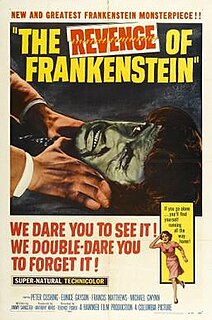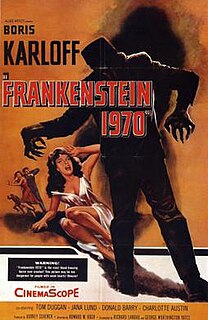The horror novel Frankenstein by Mary Shelley has inspired a number of films:

Frankenstein; or, The Modern Prometheus is a novel written by English author Mary Shelley (1797–1851) that tells the story of Victor Frankenstein, a young scientist who creates a hideous, sapient creature in an unorthodox scientific experiment. Shelley started writing the story when she was 18, and the first edition of the novel was published anonymously in London on 1 January 1818, when she was 20. Her name first appeared on the second edition, published in 1823.

Mary Wollstonecraft Shelley was an English novelist, short story writer, dramatist, essayist, biographer, and travel writer, best known for her Gothic novel Frankenstein; or, The Modern Prometheus (1818). She also edited and promoted the works of her husband, the Romantic poet and philosopher Percy Bysshe Shelley. Her father was the political philosopher William Godwin, and her mother was the philosopher and feminist Mary Wollstonecraft.
From the silent film era:
- Frankenstein (1910)
- Life Without Soul (1915)
- Il mostro di Frankenstein (1920)

Frankenstein is a 1910 film made by Edison Studios. It was written and directed by J. Searle Dawley.

Life Without Soul (1915) is a lost horror film, directed by Joseph W. Smiley and written by Jesse J. Goldburg. This film is an adaptation of Mary Shelley's Gothic novel Frankenstein. The film is about a doctor who creates a soulless man. In the end, it turns out that a young man has dreamed the events of the film after falling asleep reading Shelley's novel.
A film series by Universal Studios:
- Frankenstein (1931)
- Bride of Frankenstein (1935)
- Son of Frankenstein (1939)
- The Ghost of Frankenstein (1942)
- Frankenstein Meets the Wolf Man (1943)
- House of Frankenstein (1944)
- House of Dracula (1945)
- Abbott and Costello Meet Frankenstein (1948)

Frankenstein is a 1931 American pre-Code horror monster film from Universal Pictures. It is about a scientist and his assistant who dig up corpses to build a man animated by electricity. The project goes awry when Dr. Frankenstein's assistant accidentally gives the creature an abnormal, murderer's brain. The film was directed by James Whale, and adapted from the play by Peggy Webling, which in turn was based on Mary Shelley's 1818 novel, Frankenstein; or, The Modern Prometheus. The created "monster" is portrayed by Boris Karloff in the film. A hit with both audiences and critics, the film was followed by multiple sequels and has become arguably the most iconic horror film in history.

The Bride of Frankenstein is a 1935 American science-fiction horror film, the first sequel to Universal Pictures' 1931 hit Frankenstein. It is considered one of the few sequels to a great film that is even better than the original film on which it is based. As with the first film, Bride of Frankenstein was directed by James Whale and stars Boris Karloff as the Monster. The sequel features Elsa Lanchester in the dual role of Mary Shelley and the Monster's mate at the end of the film. Colin Clive reprises his role as Henry Frankenstein, and Ernest Thesiger plays the role of Doctor Septimus Pretorius.

Son of Frankenstein is a 1939 horror film directed by Rowland V. Lee, and is the third entry in Universal Studios' Frankenstein series and the last to feature Boris Karloff as the Monster. It is also the first to feature Bela Lugosi as Ygor. The film is the sequel to James Whale's Bride of Frankenstein, and stars top-billed Basil Rathbone, Karloff, Lugosi and Lionel Atwill.
A film series by Hammer Film Productions:
- The Curse of Frankenstein (1957)
- The Revenge of Frankenstein (1958)
- The Evil of Frankenstein (1963)
- Frankenstein Created Woman (1967)
- Frankenstein Must Be Destroyed (1969)
- The Horror of Frankenstein (1970)
- Frankenstein and the Monster from Hell (1974)

The Curse of Frankenstein is a 1957 British horror film by Hammer Film Productions, loosely based on the novel Frankenstein (1818) by Mary Shelley. It was Hammer's first colour horror film, and the first of their Frankenstein series. Its worldwide success led to several sequels, and the studio's new versions of Dracula (1958) and The Mummy (1959), and established "Hammer Horror" as a distinctive brand of Gothic cinema.

The Revenge of Frankenstein is a 1958 British horror film made by Hammer Film Productions. Directed by Terence Fisher, the film stars Peter Cushing, Francis Matthews, Michael Gwynn and Eunice Gayson. In the US, it was released in June, 1958 on a double bill with Curse of the Demon.

The Evil of Frankenstein is a 1964 film directed by Freddie Francis. It stars Peter Cushing and New Zealand wrestler Kiwi Kingston. The film's version of the Monster is noted for resembling the one in Universal Pictures' original Frankenstein series of the 1930s and 1940s, including the distinctive laboratory sets as well as the flat-headed look of Jack Pierce's monster make-up which had been designed for Boris Karloff. Earlier Frankenstein films by Hammer had studiously avoided such similarities for copyright reasons. However, a new film distribution deal had been made between Hammer and Universal. As a result, Hammer had free rein to duplicate make-up and set elements.
Other adaptations of the novel:
- Flesh for Frankenstein (1973)
- Frankenstein: The True Story (1973)
- Frankenstein Unbound (1990)
- Frankenstein (1992 film) (1992)
- Mary Shelley's Frankenstein (film) (1994)
- Frankenstein (US TV miniseries) (2004)
- Frankenstein (2004 film) (2004)
- Frankenstein (2007 film) (2007)
- Frankenstein (2015 film) (2015)

Flesh for Frankenstein is a 1973 horror film written and directed by Paul Morrissey. It stars Udo Kier, Joe Dallesandro, Monique van Vooren and Arno Juerging. Interiors were filmed at Cinecittà in Rome by a crew of Italian filmmakers.

Frankenstein: The True Story is a 1973 British and American made-for-television horror film loosely based on the novel Frankenstein by Mary Shelley. It was directed by Jack Smight, and the screenplay was written by novelist Christopher Isherwood and his longtime partner Don Bachardy.

Frankenstein Unbound is a 1990 science fiction horror film movie based on Brian Aldiss' novel of the same name, starring John Hurt, Raúl Juliá, Bridget Fonda, Jason Patric, and Nick Brimble. The film is co-written and directed by Roger Corman, returning to the director's chair after a hiatus of almost twenty years. This is his final directorial effort to date, for which he was paid $1 million to direct.
Adaptations loosely based on the novel:
- Frankenstein 1970 (1958)
- Young Frankenstein (1974)
- The Bride (film) (1985)
- I, Frankenstein (2014)
- Victor Frankenstein (2015)
- The Frankenstein Chronicles (2015 TV Series)

Frankenstein 1970 is a 1958 science fiction/horror film, shot in black and white CinemaScope, starring Boris Karloff and featuring Don "Red" Barry. The independent film was directed by Howard W. Koch, written by Richard Landau and George Worthing Yates and produced by Aubrey Schenck. It was released theatrically in some markets on a double feature with the Zsa Zsa Gabor film Queen of Outer Space.

Young Frankenstein is a 1974 American comedy horror film directed by Mel Brooks and starring Gene Wilder as the title character, a descendant of the infamous Dr. Victor Frankenstein, and Peter Boyle as the monster. The supporting cast includes Teri Garr, Cloris Leachman, Marty Feldman, Madeline Kahn, Kenneth Mars, Richard Haydn, and Gene Hackman. The screenplay was written by Wilder and Brooks.

The Bride is a 1985 British-American horror film directed by Franc Roddam and written by Lloyd Fonvielle, based on Mary Shelley's novel Frankenstein. The film stars Sting as Baron Charles Frankenstein and Jennifer Beals as Eva, a woman he creates in the same fashion as his infamous monster.
| This article includes a list of related items that share the same name (or similar names). If an internal link incorrectly led you here, you may wish to change the link to point directly to the intended article. |








